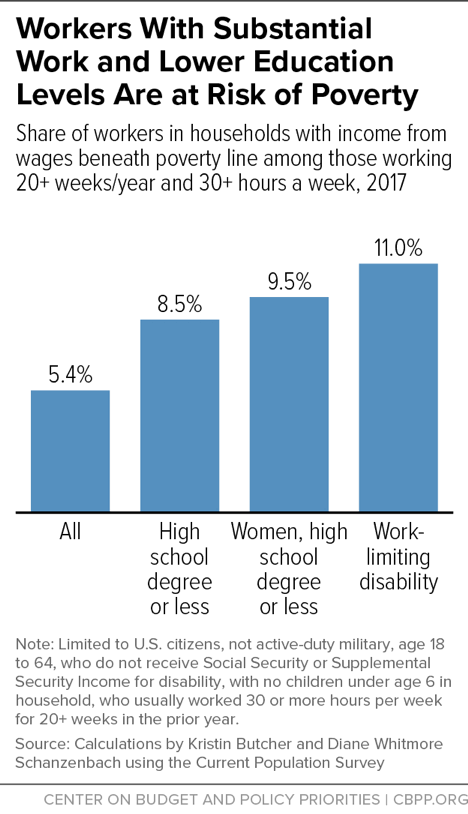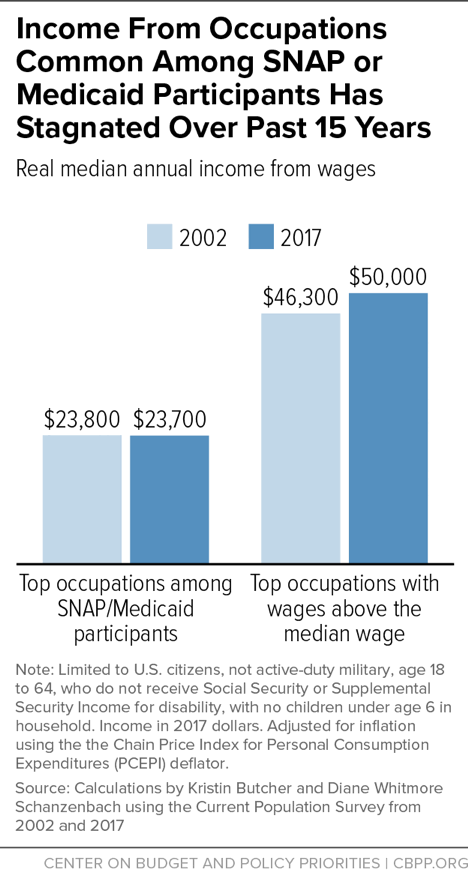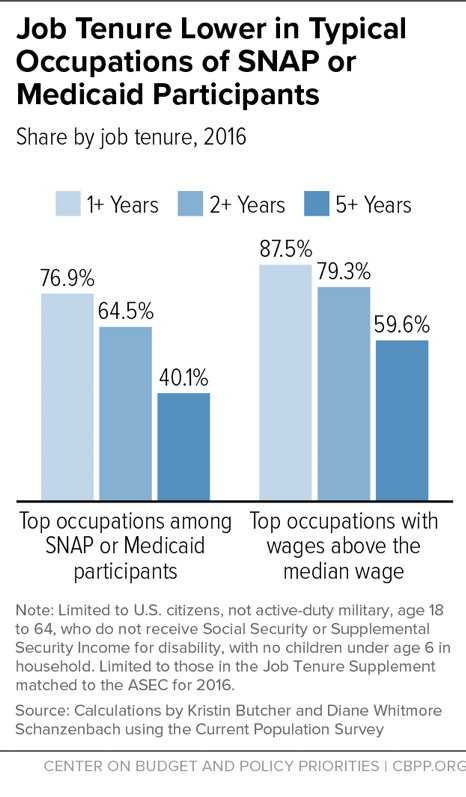- Home
- Poverty And Inequality
- Policy Brief: Labor Market Facing SNAP A...
Policy Brief: Labor Market Facing SNAP and Medicaid Participants Offers Low-Paying, Volatile Jobs
A new paper by two leading academic researchers shows how adults who are likely to participate in SNAP (formerly food stamps) or Medicaid are generally working, but they often earn low wages and experience little wage growth, high unemployment rates, and job volatility.[1] In recent months, lawmakers have proposed policies to take away food assistance or health care coverage from people who aren’t working a specified number of hours. The new findings suggest that some workers may struggle to find jobs that provide sufficient stability to meet such work requirements, and even if people subject to these requirements can comply through working a sufficient number of hours each week or month, that work does not guarantee an income that will lift them out of poverty. This research and experience from other benefit programs suggest that such work requirements would be unlikely to improve economic opportunity for those participants and would increase hardship for many. This research and experience from other benefit programs suggest that such work requirements would be unlikely to improve economic opportunity for those participants and would increase hardship for many.
The new research, commissioned by CBPP from economists Kristin F. Butcher of Wellesley College and Diane Whitmore Schanzenbach of Northwestern University, describes employment outcomes for people around whom current policy discussions about work requirements are largely centered: non-disabled adults who do not have young children (under the age of 6) at home. While the analysis is not limited to beneficiaries, it focuses on employment outcomes among people who are disproportionately likely to participate in SNAP or Medicaid, including those with a high school degree or less. The research finds:
- Most of these adults worked: more than two-thirds of women with a high school diploma or less (69 percent), and 74 percent of all individuals with a high school diploma or less, worked in the last year. Those who reported not working most commonly cited going to school, caregiving responsibilities, and early retirement as the reasons for not working.
- Among those who worked, most worked substantially. Some 85 percent of all workers, 78 percent of women with a high school diploma or less, and 70 percent of people who reported a work-limiting health condition, usually worked at least 30 hours a week and at least 20 weeks out of the year.
- Although workers with lower education levels worked substantially, their wages have been flat, and poverty rates are higher among these workers. While overall median income from wages and salaries increased somewhat from 2002 to 2017 (after adjusting for inflation) among all workers who worked at least 30 hours a week for at least 20 weeks of the year — rising from $39,700 to $42,300 — it has been relatively flat or declining for workers with low levels of education.
- Overall, about 5.4 percent of all workers employed at least 30 hours a week for at least 20 weeks of the year lived in households in which income from wages was below the poverty line in 2017, but 8.5 percent of such workers with a high school diploma or less, and 9.5 percent of female workers with a high school diploma or less, lived in such households. (See Figure 1.)
- Workers faced a relatively volatile labor market, and one year’s success did not always carry over to the next. When matching data among workers from year to year, Butcher and Schanzenbach found that when these adults worked substantially in one year, on average their hours, weeks worked, and total income fell in the following year. Similarly, when Butcher and Schanzenbach looked at workers who had substantial work in the second year, they found that the preceding year was typically a lower-income year. This is because when the sample is limited to individuals who had a relatively good year in the first year, chances are that the volatile labor market will deal them a relatively bad year in the subsequent year.
The analysis also examined labor market outcomes among all workers in the ten occupations most common among SNAP or Medicaid participants (not just participants themselves), finding that:
- Median income from wages among workers in the jobs most common among SNAP or Medicaid participants (such as health aides, cashiers, and cooks) fell slightly from 2002 to 2017 after adjusting for inflation. It rose, however, among workers in occupations with wages above the median, or middle-class occupations (such as managers, sales supervisors, nurses, and teachers). (See Figure 2.)
- The unemployment rate among those who last worked in a job most common among SNAP or Medicaid beneficiaries was over twice as high as among those working in jobs with wages above the median.
- Workers in jobs most typical among SNAP or Medicaid participants were less likely to be consistently employed over time and more likely to experience displacement.[2] While 84.9 percent of workers with above-median wages were employed at least 30 hours per week for at least 20 weeks of the year for both 2016 and 2017, only 64.3 percent of workers in jobs common among SNAP or Medicaid participants were. Close to 10 percent of those working in jobs typical among SNAP or Medicaid participants reported being displaced from a job in the three years before 2016, compared to 6.3 percent in middle-class occupations. And, workers in jobs with above-median wages were more likely to work for a single employer for longer periods of time. (See Figure 3.)
Policy Implications
This research has important implications for current policy debates around SNAP and Medicaid. Most adults who are likely participants in programs such as SNAP or Medicaid are or have been working, but in a labor market where wages are largely stagnant, poverty is relatively high, and work tends to be less stable. The nature of this labor market helps explain why policies that would take away food assistance or health insurance coverage from adults who aren’t working a set number of hours every week would increase hardship and be unlikely to improve participants’ long-term economic security. Butcher and Schanzenbach’s research also aligns with experience from cash assistance programs, which shows that work requirements generally do not have a lasting impact on poverty.[3]
When participants work, they generally work in low-wage labor markets. These jobs are volatile and do not guarantee sufficient wages to lift people out of poverty. Many still need Medicaid or SNAP to meet basic needs even when working. Some may also experience periods when they are out of work, and these requirements would put their food assistance benefits or health coverage at risk when they need that support most. As a result, work requirements would likely do little to increase employment and instead put many low-income workers at risk of losing benefits.
If policymakers want to promote opportunity for low-income Americans, the evidence suggests that other policies would be more effective than work requirements at doing so without increasing hardship, such as targeted skills-based training programs, providing more work opportunities for individuals facing barriers to employment, improving supports such as child care, and improving the quality of jobs.[4]
Issue Brief: Most Working-Age SNAP Participants Work, But Often in Unstable Jobs
End Notes
[1] Kristin F. Butcher and Diane Whitmore Schanzenbach, “Most Workers in Low-Wage Labor Market Work Substantial Hours, in Volatile Jobs,” Center on Budget and Policy Priorities, July 24, 2018, https://www.cbpp.org/research/food-assistance/most-workers-in-low-wage-labor-market-work-substantial-hours-in-volatile. Butcher is the Marshall I. Goldman Professor of Economics at Wellesley College. Whitmore Schanzenbach is the Margaret Walker Alexander Professor of Education and Social Policy and Director of the Institute for Policy Research at Northwestern University.
[2] The analysis counts individuals as displaced if they report losing or leaving a job because the plant or company closed or moved, their position or shift was abolished, or another similar reason.
[3] LaDonna Pavetti, “Work Requirements Don’t Cut Poverty, Evidence Shows,” Center on Budget and Policy Priorities, updated June 7, 2016, https://www.cbpp.org/research/poverty-and-inequality/work-requirements-dont-cut-poverty-evidence-shows.
[4] Tazra Mitchell, “Promising Policies Could Reduce Economic Hardship, Expand Opportunity for Struggling Workers,” Center on Budget and Policy Priorities, April 24, 2018, https://www.cbpp.org/research/poverty-and-inequality/promising-policies-could-reduce-economic-hardship-expand-opportunity.
More from the Authors



